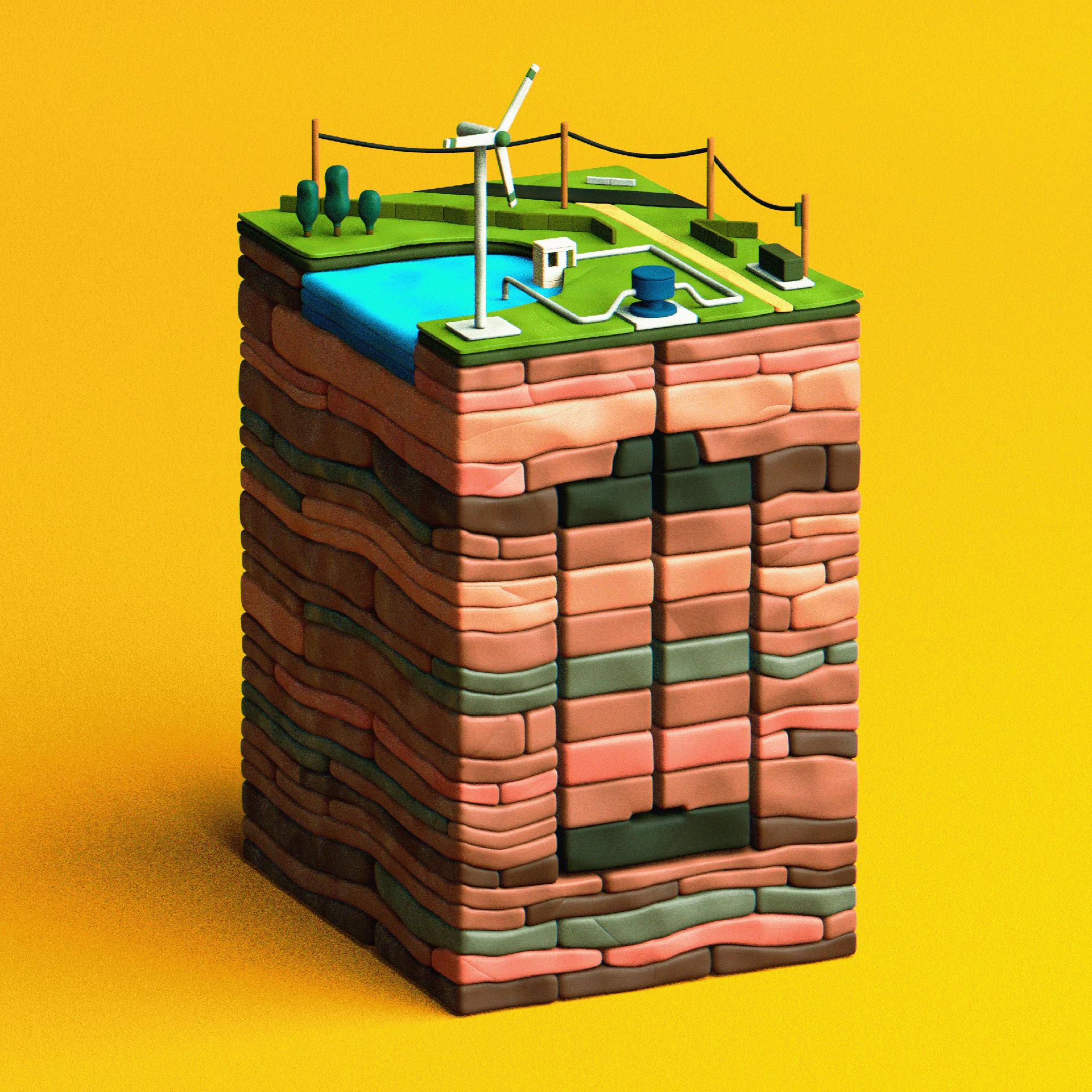Can gravity, pressure, and other elemental forces save us from becoming a battery-powered civilization?
The German word Dunkelflaute means “dark doldrums.” It chills the hearts of renewable-energy engineers, who use it to refer to the lulls when solar panels and wind turbines are thwarted by clouds, night, or still air. On a bright, cloudless day, a solar farm can generate prodigious amounts of electricity; when it’s gusty, wind turbines whoosh neighborhoods to life. But at night solar cells do little, and in calm air turbines sit useless. These renewable energy sources stop renewing until the weather, or the planet, turns.
The dark doldrums make it difficult for an electrical grid to rely totally on renewable energy. Power companies need to plan not just for individual storms or windless nights but for Dunkelflaute that stretch for days or longer. Last year, Europe experienced a weeks-long “wind drought,” and in 2006 Hawaii endured six weeks of consecutive rainy days. On a smaller scale, factories, data centers, and remote communities that want to go all-renewable need to fill the gaps. Germany is decommissioning its nuclear power plants and working hard to embrace renewables, but, because of the problem of “intermittency” in its renewable power supply, it remains dependent on fossil fuels—including imported Russian gas.
The obvious solution is batteries. The most widespread variety is called lithium-ion, or Li-ion, after the chemical process that makes it work. Such batteries power everything from mobile phones to electric vehicles; they are relatively inexpensive to make and getting cheaper. But typical models exhaust their stored energy after only three or four hours of maximum output, and—as every iPhone owner knows—their capacity dwindles, little by little, with each recharge. It is expensive to collect enough batteries to cover longer discharges. And batteries can catch fire—sites in South Korea have ignited dozens of times in the past few years.
Venkat Srinivasan, a scientist who directs the Argonne Collaborative Center for Energy Storage Science (ACCESS), at the Argonne National Laboratory, in Illinois, told me that one of the biggest problems with Li-ion batteries is their supply chain. The batteries depend on lithium and cobalt. In 2020, some seventy per cent of the world’s cobalt came from the Democratic Republic of the Congo. “Unless we have diversity, we’re going to be in trouble,” Srinivasan said. Any disruption to the supply chain can strongly affect prices and availability. Moreover, a lot of water and energy are required for mining the metals, which can cause environmental damage, and some cobalt-mining operations involve child labor. Experts doubt that Li-ion prices will drop more than thirty per cent below their current levels without significant technological advancements—a drop that is still too small, according to the Department of Energy. We need to expand our capacity; by one estimate, we’ll require at least a hundred times more storage by 2040 if we want to shift largely to renewables and avoid climate catastrophe. We may somehow find clean and reliable ways to mine, distribute, and recycle the ingredients for Li-ion batteries. And yet that seems unlikely. Although we usually think about renewable energy in terms of its sources, such as wind turbines and solar panels, that’s only half the picture. Ideally, we’d pair renewable energy with renewable storage.
We already have one kind of renewable energy storage: more than ninety per cent of the world’s energy-storage capacity is in reservoirs, as part of a remarkable but unsung technology called pumped-storage hydropower. Among other things, “pumped hydro” is used to smooth out spikes in electricity demand. Motors pump water uphill from a river or a reservoir to a higher reservoir; when the water is released downhill, it spins a turbine, generating power again. A pumped-hydro installation is like a giant, permanent battery, charged when water is pumped uphill and depleted as it flows down. The facilities can be awe-inspiring: the Bath County Pumped Storage Station, in Virginia, consists of two sprawling lakes, about a quarter of a mile apart in elevation, among tree-covered slopes; at times of high demand, thirteen million gallons of water can flow every minute through the system, which supplies power to hundreds of thousands of homes. Some countries are expanding their use of pumped hydro, but the construction of new facilities in the United States peaked decades ago. The right geography is hard to find, permits are difficult to obtain, and construction is slow and expensive. The hunt is on for new approaches to energy storage.
Quidnet, a Houston-based startup, is one of many companies exploring the possibilities. Last month, I sat in an F-150 King Ranch pickup with Scott Wright, its vice-president of operations, and Jason Craig, its C.O.O., as we drove to one of its test sites, on a farm west of San Antonio. Fields and billboards whizzed by as Craig explained, from the back seat, that Quidnet had patented a new kind of pumped hydro. Instead of pumping water uphill, the company’s system sends it underground through a pipe reaching at least a thousand feet down. Later, the system lets the Earth squeeze the water back up under pressure, using it to drive generators. Wright and Craig are veterans of the oil and gas industry, and Quidnet’s technology is like a green riff on fracking. In that technique, fluid is injected underground, where it builds up pressure that fractures rocks, releasing natural gas. Quidnet uses some of the same equipment and expertise, but with a different goal: the water is meant to be sandwiched between layers of rock, forming underground reservoirs that can be released on demand.
As we drove, I asked about the blackouts Texas experienced in February of 2021, when a winter storm shut down gas plants for several days and left millions without power. More than two hundred people died. The crisis had many causes, including the fact that Texas is the only state whose power grid isn’t connected to grids in other states. “We were pulling buckets of water out of the neighbor’s pool to get toilets to flush,” Wright said. “It definitely screams for some way to store power to lessen the burden on the grid in times like that.”
The artificial underground reservoirs created by companies like Quidnet are known to engineers as “lenses,” because of their shape. (“I say whoopee cushion and people don’t like it,” Craig said.) Initially, Quidnet encountered skepticism about its ability to form lenses of the right size and shape. By the time I visited, however, it had successfully completed multiple pumping cycles in Texas, Ohio, and Alberta. The company has received thirty-eight million dollars in private and government funding, including contributions from Breakthrough Energy Ventures, established by Bill Gates.
Quidnet has benefitted from an energy-storage gold rush. In 2018, the Department of Energy awarded thirty million dollars in funding to ten groups, including Quidnet, through a program called Duration Addition to electricitY Storage, or DAYS. Before leaving office, President Donald Trump signed into law the Energy Act of 2020, which included the bipartisan Better Energy Storage Technology (BEST) Act, authorizing a billion dollars to be spent over five years on the “research, development, and demonstration” of new energy-storage technology. Many states are now setting storage-capacity targets, and in 2018 the Federal Energy Regulatory Commission issued Order 841, which integrates stored energy into the wholesale electricity market. “There’s been a recognition that this is a technology whose time has come,” Jason Burwen, of the American Clean Power Association, told me. But a vast distance separates an engineer’s whiteboard from reality. Many renewable-storage technologies receiving funding will turn out to be too impractical, expensive, or inefficient for widespread adoption.
As we approached the farm, Craig mused on the raw physicality of many companies’ approaches. The basic principles are ones you might recall from high-school physics. If you put effort into lifting an object, it stores potential energy; if you then let that object fall, its potential energy becomes kinetic energy, which is capable of powering a generator and creating electricity. The same holds for many physical actions. In addition to lifting weights, energy-storage companies are compressing air or water, or making objects spin, or heating them up. If you use clean energy to do the initial work and find a green way to store and release it, you’ve created an ecologically responsible battery alternative.
“I’m kind of surprised and encouraged that the solutions to the long-duration-energy-storage problem could be the caveman stuff,” Craig said. Batteries depend on “pretty sophisticated electrochemistry that quickly gets outside of what I understand. And yet the solutions may be picking up heavy stuff with cranes, picking up the earth with a hydraulic jack. I think there’s some fellas in Nevada that are putting rocks in a train and rolling it uphill, then they come back down. Like, Fred Flintstone would be comfortable with most of this stuff. It could be the way.”
We pulled into the farm’s long drive. A kettle of vultures circled overhead.
“You know what that means?” Craig asked.
“The last reporter who came out here?” I said.
They laughed. “That’s right. Too many bad questions.”
I already had one in mind. Was I about to see part of the future of green energy, or a curious and short-lived experiment in rural Texas?
Until recently, we didn’t have to think much about new ways to store our energy. Fossil fuels are a prehistoric energy repository, and we could unlock their energy by burning them and driving generators. There was always more fuel to burn. “Almost all electricity in the world is used as it’s made,” Bill Gross, a longtime investor in solar power and a co-founder of Energy Vault, one of the most highly capitalized new energy-storage companies, told me. Most power that isn’t consumed immediately is lost. The problem is that, with many technologies, “it actually costs more to store electricity than to make it,” he said. In many cases, solar and wind have become less expensive than coal and gas. But add the cost of storage, and renewables can lose to fossil fuels.
Energy is stored all around us, in all sorts of ways. A bottle of fizzy water in your fridge holds energy under pressure; a tower of books contains energy, which is released when it falls. On a larger scale, volcanic eruptions and avalanches release stored energy. But energy storage is most useful when it is predictable, convenient, and dense, packing lots of power into a small space. Climate change notwithstanding, fossil fuels meet all these requirements: by burning just a gallon of easily transported gasoline, you can release enough energy to move thousands of gallons of water from the bottom of a pumped-hydro station to the top.





